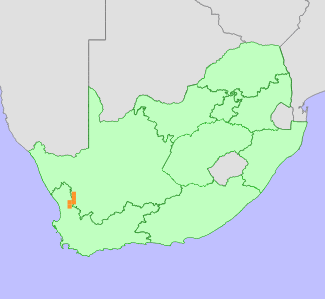|
Scientific Name | Conophytum comptonii N.E.Br. |
Higher Classification | Dicotyledons |
Family | AIZOACEAE |
National Status |
Status and Criteria | Critically Endangered A3c |
Assessment Date | 2021/11/17 |
Assessor(s) | A.J. Young, P.G. Desmet, I. Ebrahim, D. Guo, A. Harrower, L. Jabar, L. Knoetze, C. Rodgerson, P.C.V. Van Wyk & N.N. Mhlongo |
Justification | This dwarf succulent species is endemic to the Western Cape and Northern Cape provinces of South Africa where it is recorded from multiple locations with an extent of occurrence (EOO) and area of occupancy (AOO) of 1,311 and 104 km², respectively. It has been targeted by illegal collection in recent years and there has been a recent rapid and substantial loss of mature individuals due to illegal collection for the specialist succulent trade. A large number of plants have been removed since 2019 and the remaining plants are threatened as this species remains highly sought after in the illegal ornamental succulent marketplace. The threat of illegal collection is therefore regarded as very high for this particular species but its distribution across several locations may likely limit the decline to no more than 75% of the population.
There has been no loss of vegetation cover across the geographic range occupied by this species as inferred from changes in Enhanced Vegetation Index (EVI) between 1984 and 2018 using Landsat data (Venter et al. 2020). However, future changes to the climate remain a potential threat. Modelling of climate change impacts is predicted to result in an almost complete loss (99%) of suitable bio-climatic habitat by 2080 under likely CO2 emission scenarios (RCP 2.6). Species in this genus have limited dispersal ability and migration to suitable habitats elsewhere is regarded as highly unlikely. This species therefore qualified for listing as Critically Endangered under criterion A3. |
Distribution |
Endemism | South African endemic |
Provincial distribution | Northern Cape, Western Cape |
Range | This species is endemic to the Western Cape and Northern Cape provinces of South Africa where it has a restricted range. |
Habitat and Ecology |
Major system | Terrestrial |
Major habitats | Bokkeveld Sandstone Fynbos |
Description | This species is endemic to the Fynbos biome, where it is found in Bokkeveld Sandstone Fynbos. The plants inhabit shallow weathered pans on Table Mountain sandstone filled with fine grit and/or sand. Plants are often scattered but can be locally very abundant. This species has a generation length of 30 years. It is expected to be sensitive to the impacts of climate change as it does not disperse and while adapted to arid conditions, is dependent on limited seasonal rainfall. Species in the genus are sensitive to long periods of drought. Drought related mortality has been observed for other closely related taxa within the genus. |
Threats |
| This species is currently threatened by illegal collection for the succulent trade with >18,000 plants seized from poachers by the authorities in South Africa in 2020-21 alone. There is evidence that thousands of illegally collected plants have been exported overseas. This is likely to increase in future as there has been a dramatic increase in the number of species and volume of plants targeted since 2019.
Anthropogenic climate change is a long-term threat to this species. Climate models for the likely emission scenarios where emissions stay at present day levels (RCP 2.6) (Hausfather and Peters 2020) and worst case scenarios where emissions continue to increase during the 21st century (RCP 8.5) indicate that there will be a loss of suitable bioclimatic envelope of between 99% and 100% by 2080 for this species. Species in this genus have limited dispersal ability and migration to suitable habitats elsewhere is regarded as highly unlikely.
The species is primarily found on farmland and trampling by livestock is a localised threat. In general, the rocky areas the plants inhabit are not threatened by other current agricultural practices in the area. |
Population |
There is no accurate determination of the number of mature individuals of this species in habitat. There is, however, a reasonable consensus between three experts on the genus who have visited the known subpopulations for this species in the last 30 years of 75-125,000 individual plants. The population is declining due to illegal collection to support the ornamental succulent plant trade, in the long term the population is also likely to decline as a result of extended drought caused by climate change.
|
Population trend | Decreasing |
Assessment History |
Taxon assessed |
Status and Criteria |
Citation/Red List version | | Conophytum comptonii N.E.Br. | NT B1ab(v)+2ab(v) | 2020.1 | | Conophytum comptonii N.E.Br. | Least Concern | Raimondo et al. (2009) | |
Bibliography |
Hammer, S. 2002. Dumpling and his wife: New view of the genus Conophytum. EAE Creative Colour, Norwich.
Hammer, S.A. 1993. The genus Conophytum: A conograph. Succulent Plant Publications, Pretoria.
Hausfather, Z. and Peters, G.P. 2020. Emissions - the 'business as usual' story is misleading. Nature 577(618-620).
|
Citation |
| Young, A.J., Desmet, P.G., Ebrahim, I., Guo, D., Harrower, A., Jabar, L., Knoetze, L., Rodgerson, C., Van Wyk, P.C.V. & Mhlongo, N.N. 2021. Conophytum comptonii N.E.Br. National Assessment: Red List of South African Plants version 2024.1. Accessed on 2025/11/07 |
 Comment on this assessment
Comment on this assessment


